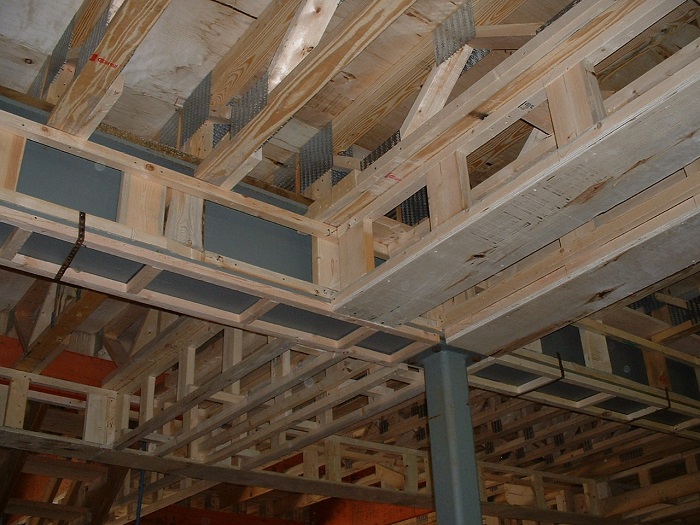
By Gregory Havel
The previous article in this series reviewed the development of fire, especially fires in compartments inside buildings.
Fire development may be most rapid in a compartment in which the surfaces are highly combustible or ignitable, including the following:
- Carpeted floors or walls.
- Heavily-waxed wood floors, wall paneling, or tongue-and-groove boards.
- Easily-ignited materials, i.e., fiberboard paneling, wallpaper, draperies, low-density fiberboard acoustic tiles, on walls and ceilings.
The use of highly combustible or easily-ignitable surfaces in a compartment leads to the following:
- Reduced time to rollover and flashover.
- Reduced time to burn-through of the combustible surfaces.
- Reduced time to exposure of the concealed spaces behind the combustible surfaces, which are not sprinklered in many construction types.
- Rapid ignition of the surfaces in the concealed spaces if they are combustible. Photo 1 shows the wood framing surrounding structural steel, which supports lightweight wood trusses. Photo 2 shows wood lath supporting plaster in wood frame construction.
- Expansion of superheated products of combustion into the concealed spaces, even if they are not combustible (photo 3).
- Extension of the fire through interconnected concealed spaces (see photo 1) and into occupied spaces with breaks in the fire-resistive assemblies.

(1) Photos by author.
(2)

(3)
Note that even concealed spaces within fire resistive assemblies (walls, floor-ceilings) (photo 4) can serve as ducts or chimneys for fire extension since their fire resistance applies only with a fire on one side of the wall or floor-ceiling and ambient temperature on the other. Fire resistance does not apply if the fire or superheated gases are inside the fire-rated assembly.
(4)
The further result is the extension of the fire into unsuspected areas of the building as well as rapid failure of load-bearing walls and other assemblies if their interiors are combustible or from being weakened by heat if they are not combustible.
A modern or an older building that has recently been renovated is likely to have the concealed spaces inside walls interconnected with the concealed spaces in floor-ceiling assemblies. In addition, balloon framing in either wood-frame or noncombustible buildings (photo 5) can carry superheated products of combustion throughout the concealed spaces on the floor of fire origin as well as vertically to the concealed spaces on the floors above.
(5)
In addition, these interconnected concealed spaces are likely to contain load-bearing members such as wood or metal studs and structural steel columns and beams (as in photos 1, 4, and 5). Fire extension into a concealed space in a compartment can rapidly endanger the structural stability of the building by burning away or weakening by heat the load-bearing members inside.
The behavior of the fire in concealed spaces, in addition to the high rate of heat release from today’s room furnishings and the reduced mass of structural members, is a primary reason that firefighters can no longer depend on having as much as 20 minutes after arrival to have an impact on the fire. The National Institute for Occupational Safety and Health’s fatality reports and research by Underwriters Laboratories Fire Safety Research Institute and the National Institute of Standards and Technology show that buildings on fire are ready to collapse on our arrival. This means that you must modify traditional firefighting tactics and strategies to keep firefighters out of harm’s way.
Preincident planning is essential to this effort, as is the installation of automatic fire sprinkler systems in both occupied and concealed spaces to prevent the fire from breaking out of the room of fire origin and spreading throughout the building.
Download this article as a PDF HERE
 Gregory Havel is a member of the Town of Burlington (WI) Fire Department; retired deputy chief and training officer; and a 35-year veteran of the fire service. He is a Wisconsin-certified fire instructor II, fire officer II, and fire inspector; an adjunct instructor in fire service programs at Gateway Technical College; and safety director for Scherrer Construction Co., Inc. Havel has a bachelor’s degree from St. Norbert College; has more than 35 years of experience in facilities management and building construction; and has presented classes at FDIC.
Gregory Havel is a member of the Town of Burlington (WI) Fire Department; retired deputy chief and training officer; and a 35-year veteran of the fire service. He is a Wisconsin-certified fire instructor II, fire officer II, and fire inspector; an adjunct instructor in fire service programs at Gateway Technical College; and safety director for Scherrer Construction Co., Inc. Havel has a bachelor’s degree from St. Norbert College; has more than 35 years of experience in facilities management and building construction; and has presented classes at FDIC.
MORE CONSTRUCTION CONCERNS

